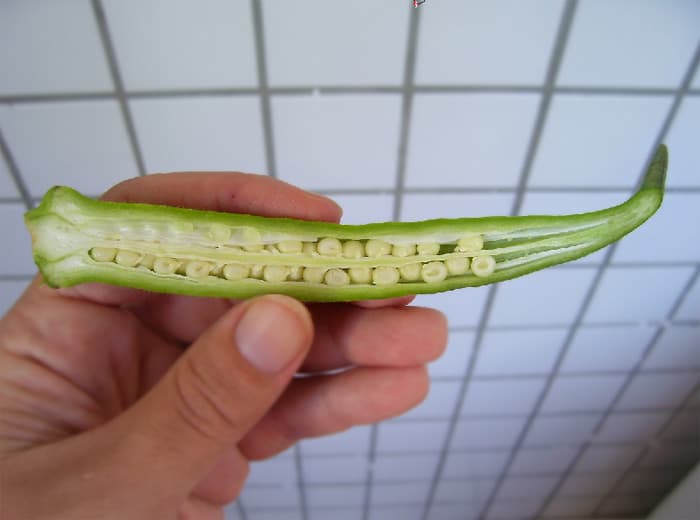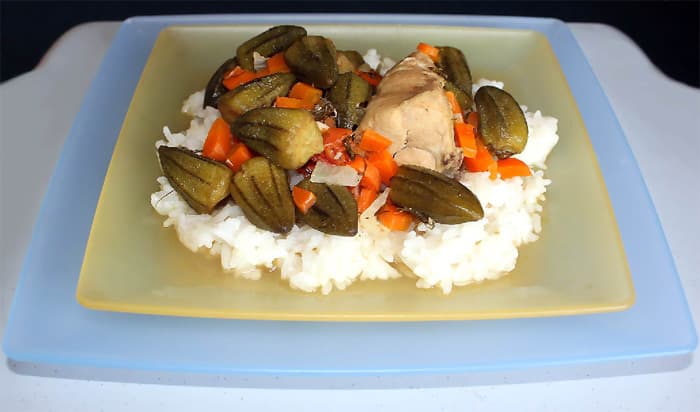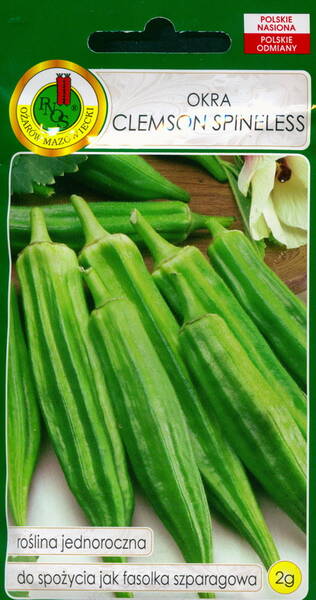Low-calorie dietary product.
Okra is an annual vegetable crop, a herbaceous plant. Okra resembles a shrub: covered with stiff hairs, a thick, rough stem branched out at the base.
The leaves of the okra are large, dark green, seven-lobed, covered with hard down. Single large cream-colored flowers with a purple spot in the middle, blooming in the leaf axils.
The fruits of okra are somewhat vaguely reminiscent of peppers: elongated green pods, covered with hairs.
Ochro is very fertile: ripe pods are harvested every 3-4 days until the end of the harvest season. You can cut 5-10 pods from one bush at a time.
This herb tastes remarkably similar to eggplant and asparagus, hence the methods for preparing okra, which are identical to the methods for preparing these foods.
But bamia is not only fried and stewed, it can also be eaten raw in various salads. Soups, snacks, meat and vegetable dishes are prepared with okra. As a side dish, it goes well with fish, poultry and meat.
Okura seeds are also a gastronomically curious product: they are fried and used instead of coffee, and a specific burning drink is brewed with them. In addition, okra seeds are used to extract oil, which is rich in unsaturated fats and has a delicate pleasant aroma. Okra leaves are used to prepare salads and soups.
1 gramm = 16-18 seeds.

* The plant is self-pollinating, in a humid climate, cross-pollination is possible, which leads to a change in varietal qualities when sowing such seeds next year.
Okra enters fruiting 60-65 days after sowing the seeds, and this process continues until the frost. The yield is high, with good care, 30-40 boxes can be collected from one copy. 3-4-day fruit ovaries are used for food - fried, boiled, in salads, soups, side dishes, in sauces and gravies, harvested for future use.
The fruits of okra contain vitamins B, C, A, a large amount of mucous substances, which makes it a valuable food for patients with peptic ulcer and gastritis.
From unripe seeds removed before frost, you can cook "green peas" - remove the seeds and preserve them.
Mature seeds make good coffee: the seeds are roasted in a frying pan without oil until a coffee aroma appears, cooled and ground in a coffee grinder. Powder for the preparation of coffee and chocolate drink does not contain caffeine, it can be drunk in the evening and at night (it is especially useful for children and the elderly).
Okra grows well on fertile, light in chemical composition soils, does not tolerate waterlogged ones, with a close location of groundwater.
The culture is easy to grow, does not require special care. Seeds are sown dry after May 9-10, when the probability of spring frosts is already small, the earth has warmed up and the temperature at night does not drop below +12 + 15 ° C, sown 2 pieces per hole (seeding depth - 2.5-3 cm). Distance between rows - 70 cm, in a row - 30 cm.
The wells are watered regardless of soil moisture, 10 days after sowing, they are watered again.
After germination (after 2-3 weeks), cut off, but do not pull out a weak plant, leaving one plant per hole.
Weeding when weeds appear, watering infrequently, but such that the earth is moistened to a depth of 30-40 cm. If necessary, the soil must be fertilized, preferably with humus and small doses of complete mineral fertilizer (taking into account the fact that you yourself will eat okra).

Eng.: Okra, Gumbo, Lady fingers, gambo, gombo, okura, ocra, bamia ochro, bhindi, bombo, chimbombo, Bhindee, Bhindi, Bindi, Cantarela, Gombaut, Bumbo, Mesta, Ochro, Okro, Quiabo, Quimbambo, Quingombo, Rosenapfel, Vendakai, qiu kui, okura. Bot. syn.: Abelmoschus esculentus.
* When is okra harvested?
Okra fruits - pods - are collected unripe, 3-4-day-old fruits.
They cannot be stored for a long time. The greens are covered with hairs, which are removed by gently wiping them with a soft cloth. Before use, they are blanched, adding citric acid or vinegar. Okra fruits do not have their own pronounced taste, so any spices are added to dishes from them: curry, chili, basil, garlic, cumin. It is especially tasty in combination with red tomatoes or sweet peppers as a side dish (instead of the usual potatoes for us) for fish, lamb, beef.
Okra can be grown even in winter on a southern windowsill!
To determine if a pod is overripe: break its tip and if it bends but does not break, then it is time to pick it.
And overripe okra pods can also be used: dried fruits look interesting in installations for winter bouquets (it is not for nothing that "advanced" florists use them when composing dry bouquets...)















